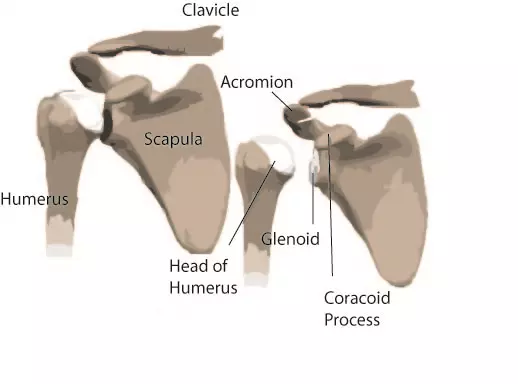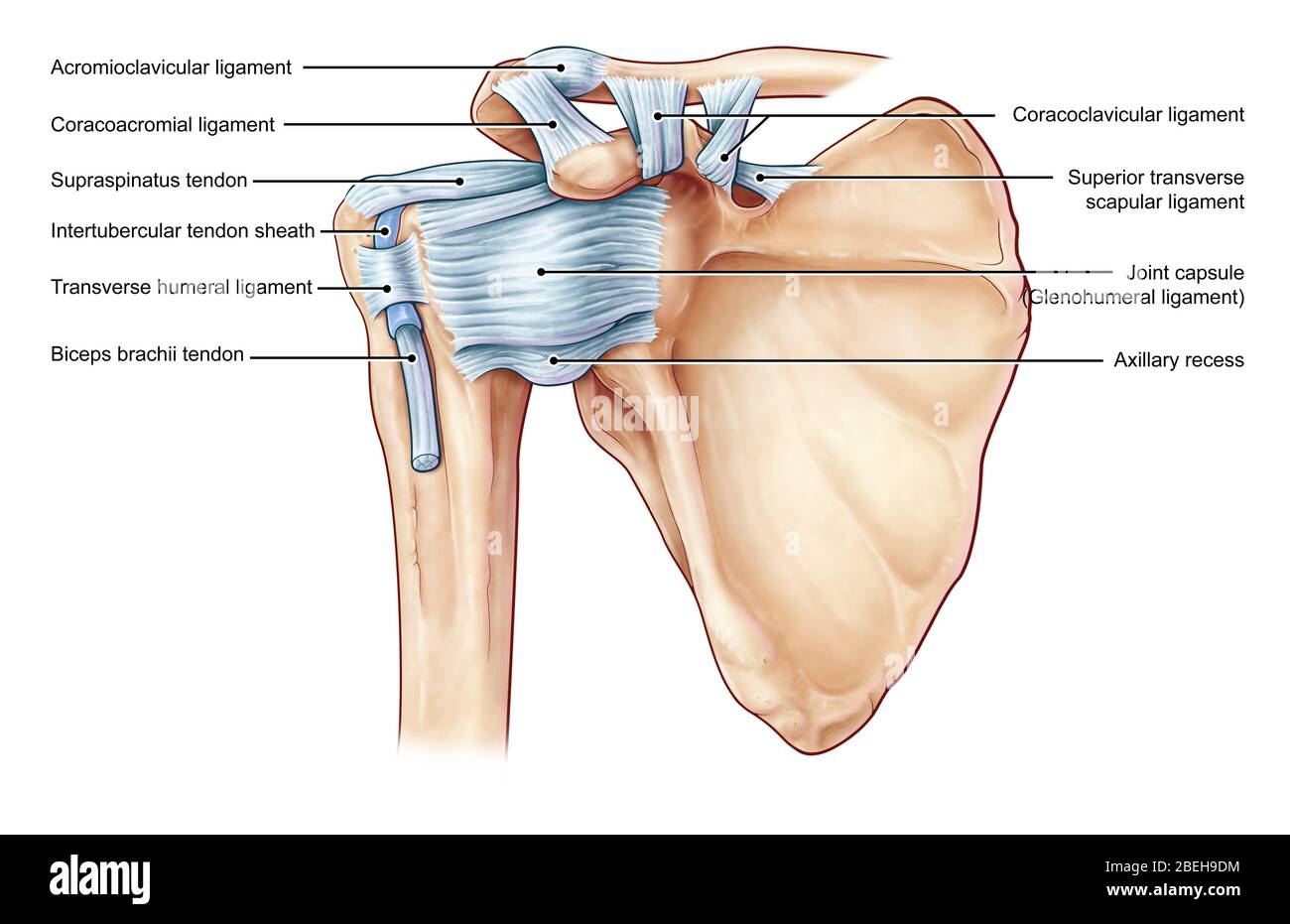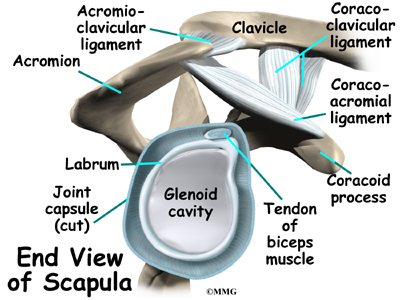Shoulder Tendon And Ligament Anatomy - Shoulder Ligament Tendon High Resolution Stock Photography And Images Alamy - 17 photos of the diagram of shoulder muscles and tendons.
Shoulder Tendon And Ligament Anatomy - Shoulder Ligament Tendon High Resolution Stock Photography And Images Alamy - 17 photos of the diagram of shoulder muscles and tendons.. These bones are necessary not only for stability but also for the protection of the rest of your shoulder structures. The shoulder joint is located between the glenoid fossa of the scapula and the humerus. These ligaments pass from the coracoid and glenoid respectively, and insert into the humeral head on either side of the biceps tendon, securing it in place. The rotator cuff is a collection of muscles and tendons that surround the shoulder, giving it support and allowing a wide range of motion. Shoulder anatomy the shoulder is an incredibly complex structure.
The shoulder is made up of two joints, the acromioclavicular joint and the glenohumeral joint. These supporting tissues are all attached to the scapula, humerus, and clavicle. In the shoulder, the joint capsule is formed by a group of ligaments that connect the humerus to the glenoid. The joints of the shoulder that are primarily responsible for movement are held together by several strong ligaments. The subacromial bursa lies between the rotator cuff and shoulder blade and protects the tendons in this area.

Shoulder dislocations can be partial, with the ball of the upper arm coming just partially out of the socket.
The shoulder girdle includes three bones—the scapula, clavicle and humerus. The subacromial bursa lies between the rotator cuff and shoulder blade and protects the tendons in this area. 17 photos of the diagram of shoulder muscles and tendons. Their job is to stabilise the shoulder joint. The supraspinatus, infraspinatus and teres minor muscles and tendons are shown. To remain in a stable or normal position, the shoulder must be anchored by muscles, tendons and ligaments. The glenohumeral joint is where the ball (humeral head) and the socket (the glenoid) meet. The coracohumeral ligament helps keep the long head of biceps in position within the upper groove, by forming a sling mechanism in conjunction with the superior glenohumeral ligament. Bursa is situated between tendon and bone or ligament and bone or between tendon and ligament. By virtue of the blending of their tendons with the glenohumeral capsule and ligaments, selective contraction of the cuff muscles can adjust the tension in these structures, producing 'dynamic' ligaments. The primary function of the shoulder girdle is to give strength and range of motion to the arm. The shoulder is not a single joint, but a complex arrangement of bones, ligaments, muscles, and tendons that is better called the shoulder girdle. Posterior graphic of the shoulder.
The shoulder is made out of a ball and socket joint created by the scapula, humerus, and the muscles, ligaments, and tendons that support those bones. To ensure proper range of motion, the shoulder joint is supported by the shoulder ligaments, shoulder tendons and shoulder muscles. Shoulder tendons chart ~ labeled anatomy chart of shoulder ligaments on white background stocktrek images. The superior ligament crosses the glenohumeral joint and connects the top portion of the head of the humerus with the glenoid fossa of the scapula. The joints of the shoulder that are primarily responsible for movement are held together by several strong ligaments.

Several ligaments make up parts of the joint capsule, and these ligaments are important in keeping the shoulder joint in proper position.
The shoulder joint is composed of the glenoid (the shallow shoulder socket) and the head of the upper arm bone known as the humerus (the ball). 17 photos of the diagram of shoulder muscles and tendons. The subacromial bursa lies between the rotator cuff and shoulder blade and protects the tendons in this area. The rotator cuff is a collection of muscles and tendons that surround the shoulder, giving it support and allowing a wide range of motion. Shoulder dislocations can be partial, with the ball of the upper arm coming just partially out of the socket. They include the coracoclavicular ligaments, the coracoacromial ligaments, the superior transverse scapular ligament, the coracohumeral ligament, the acromioclavicular ligament, and the glenohumeral ligaments. 1 this instability is. The long head of biceps (lhb) is a very important tendon that travels through the shoulder joint (glenohumeral joint). Shoulder anatomy girdle ligaments bones humerus clavical : The shoulder is not a single joint, but a complex arrangement of bones, ligaments, muscles, and tendons that is better called the shoulder girdle. They serve as the basic structure and support for the joints and ligaments that make up your shoulders as a whole. The biceps tendon begins at the top of the shoulder socket (the glenoid) and then passes across the front of the shoulder to connect to the biceps muscle. The acromioclavicular ligament and the coracoclavicular ligament both stabilize the clavicle to the shoulder blade.
Start studying shoulder ligaments and tendons. The shoulder joint is located between the glenoid fossa of the scapula and the humerus. (the biceps is the muscle that weightlifters are always showing off). The shoulder is a complex joint with many muscles that control the shoulder's wide range of motion. 17 photos of the diagram of shoulder muscles and tendons.

The shoulder joint is composed of the glenoid (the shallow shoulder socket) and the head of the upper arm bone known as the humerus (the ball).
They serve as the basic structure and support for the joints and ligaments that make up your shoulders as a whole. They include the coracoclavicular ligaments, the coracoacromial ligaments, the superior transverse scapular ligament, the coracohumeral ligament, the acromioclavicular ligament, and the glenohumeral ligaments. The joints of the shoulder that are primarily responsible for movement are held together by several strong ligaments. The scapula, clavicle, and the humerus. The shoulder joint permits a fuller range of motion than any other joint, allowing the arm to raise, lower, extend and rotate a full 360 degrees. (the biceps is the muscle that weightlifters are always showing off). Shoulder tendons chart ~ labeled anatomy chart of shoulder ligaments on white background stocktrek images. The acromioclavicular joint is where the acromion, part of the shoulder blade (scapula) and the collar bone (clavicle) meet. They are the superior, middle and inferior glenohumeral ligaments. The shoulder joint is located between the glenoid fossa of the scapula and the humerus. A tendon is a structure that connects muscle to bone, and the biceps are connected by tendons at both the elbow and shoulder joints. Furthermore, the shoulder allows for scapular protraction, retraction, elevation, and depression. The clavicle has two ligaments involving the shoulder that help with stabilizing it to nearby bony structures:
It is made up of ligaments shoulder tendon anatomy shoulder tendon anatomy. Start studying shoulder ligaments and tendons.